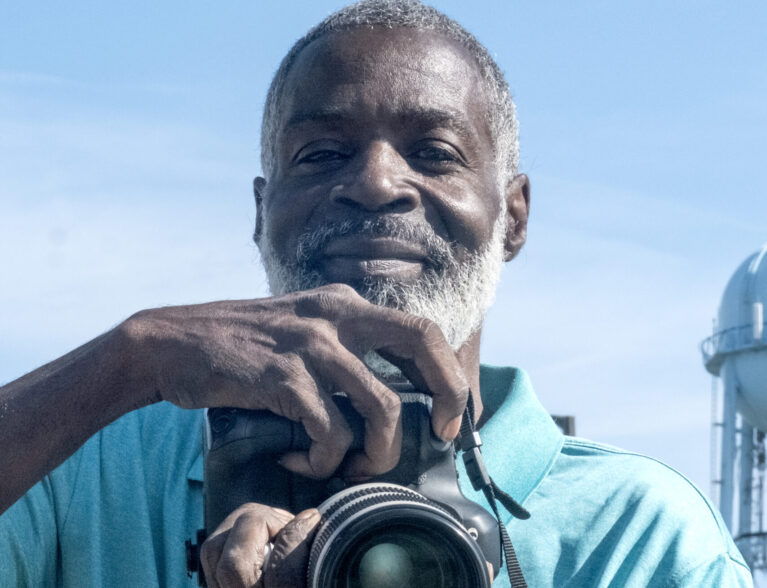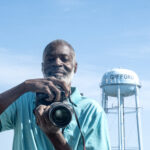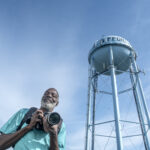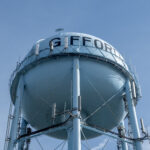
Ernie Grier’s lifelong passion for photography began as a young boy, when he was so intrigued by his aunt’s Kodak camera that he gently took it apart to discover how it worked.
By age 15, he knew that he would turn photography into a career, telling his mother that he was going to work as a photojournalist.
“My mom told me I always had big ideas,” says Grier.
Grier kept that vision and in 1980, at age 25, after serving in the Army’s Military Police Corps, he made good on his promise, working for 22 years as a press operator and photojournalist with the daily paper.
Grier’s family moved to Gifford in 1958, when lush orange groves ringed an area booming with Black-owned businesses and where working-class neighbors would relax under shaded trees.
His father worked for the Dodgers and would often take Grier and his brother to see the teams play at Dodgertown, now the Jackie Robinson Training Complex.
“(My dad) drove the Black baseball players to places in Gifford because they couldn’t hang out in Vero,” Grier recalls, referencing the “sundown” law that required Black people to leave town at nightfall.
“The Greenleaf Bar was the place to go to in Gifford at that time.”
He was inspired by such renowned community leaders as J. Ralph Lundy, who had a weekly column and was Grier’s boss at the newspaper. Lundy, known as “Gifford’s spokesman,” also founded the Our Father’s Table Soup Kitchen.
During his time at the paper, the ever-inquisitive Grier would often be the first journalist on the scene of the county’s breaking news incidents, including the 1986 shooting death of Cpl. Richard R. Raczkoski, the first deputy to be slain in Indian River County, and the subsequent hunt for his killer.
But to many Gifford residents, it was his determined advocacy to uphold the heritage of his hometown by pushing to get the town’s name emblazoned on the Gifford Water Tower that is Grier’s foremost legacy.
Water towers are symbols that give people a sense of place, according to County Commissioner Laura Moss.
“They’re unique. You look up, see the name and you feel proud of your community,” says Moss. “Ernie was very determined in a caring way. It never would’ve happened without him.”
That determination had actually begun some 50 years earlier, when he watched as the 154-foot-tall tower was built in the heart of the unincorporated town during the late 1970s. It was the first water tower for Indian River County Utilities and is one of three owned and operated by the county.
In his early 20s at the time, Grier wrote a letter to the editor where he addressed the county commissioners asking why the Gifford name could not be put on the tower.
“I always felt that Gifford was slighted.”
After decades of persistence, his personal campaign finally succeeded.
In 2021, the Gifford name was added onto the southwest quadrant of the tower at the minimal cost of $6,950, according to county officials, who say the landmark now operates as a cellphone tower.
“It looks majestic,” Grier says. “The name finally got put on the water tower. I’m satisfied with that.”
The Board of Indian River County Commissioners honored Grier earlier this year for his photography, activism and community impact.
Although a self-described introvert who prefers to be behind the camera lens, Grier became the center of attraction during the Martin Luther King Jr. Banquet at the Gifford Youth Achievement Center when Commissioner Joe Flescher presented him with a proclamation honoring his efforts.
The proclamation was presented again during the County Commission’s regularly scheduled meeting.
“Ernie James Grier exemplifies the true spirit of this honor through his service to our nation, county, and our citizens. As a photographer/photographic journalist, Ernie documented and preserved history for the community,” Flescher told Vero Beach 32963.
“Through his lens today, he continues to record life in Gifford, Indian River County in a unique perspective. Future generations will know this community because Ernie cared to take the time to photograph,” Flescher added.
“I’m proud of my community. I’m proud of Indian River County. I’m glad I was born here. I wouldn’t want to be anywhere else,” Grier told the commissioners that day.
It was one of many in a long line of battles by civic leaders to get attention for the town’s concerns. One of the most critical was obtaining clean water.
Before Gifford was connected to the county water system, the filthy yellow and brown water that poured from residents’ faucets was a health hazard that plagued the predominantly Black town, even garnering national attention in 1977 on CBS Evening News.
“I stopped drinking water back then,” Grier said. “I just started drinking water again a few years ago.”
Local leaders from the Progressive Civic League, including Lundy and former NAACP President Victor Hart Sr., began advocating for Gifford to have clean water; like Grier, fighting for residents’ recognition, change and respect.
Shortly after their plight went national, the county finally hooked the town into its water and sewer system. Other productive community advocacy resulted in paved streets, streetlights and stop signs.
The soft-spoken photographer says he doesn’t plan to put his Canon camera down anytime soon. He still enjoys looking out for the perfect moment and the right angle to freeze time in a photograph.
“My camera goes with me everywhere I go,” Grier says.
“I’m not responsible for my beginning, not sure when my end will be. But what I do in the middle to make the world a better place is what will define me.”
- PHOTO BY JOSHUA KODIS
- PHOTO BY JOSHUA KODIS
- PHOTO BY JOSHUA KODIS
- PHOTO BY JOSHUA KODIS
- PHOTO BY JOSHUA KODIS
- PHOTO BY JOSHUA KODIS
- PHOTO BY JOSHUA KODIS
- ERNIE GRIER PHOTOGRAPHY
- ERNIE GRIER PHOTOGRAPHY
- ERNIE GRIER PHOTOGRAPHY
- ERNIE GRIER PHOTOGRAPHY
- ERNIE GRIER PHOTOGRAPHY
- ERNIE GRIER PHOTOGRAPHY
- ERNIE GRIER PHOTOGRAPHY
- ERNIE GRIER PHOTOGRAPHY


















